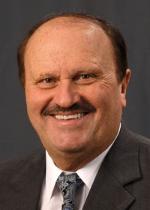
The superintendent of the Anchorage School District used the early school board meeting Thursday to highlight security issues following the lock down Tuesday at Dimond High School.
During his update to the School Board, Anchorage School District Superintendent Jim Browder said many things went right during the lock down that occurred after a student brought a gun to school Tuesday. He commended school administrators and teachers for following security procedures and Anchorage Police officers for their quick response. The district has been reviewing its security policies and procedures since the school shooting in Connecticut. Browder says the district has some important security measures in place, like doors that lock from the inside in most classrooms. But he says there are other areas that must be addressed.
“Our biggest deficit from my standpoint has to do with access to buildings and in some places we, our parents and community walk into buildings and nobody that visibly sees them immediately when they walk in,” Browder said. “And that’s probably our biggest deficit in my mind in relation with fixing the security and having it at 100 percent.”
Dimond High School went into lock down just after 9:30 a.m. Tuesday morning. A student saw another student with a gun and reported it to an administrator Police arrived within one minute and arrested the 15-year-old student with the gun within 10 minutes. No shots were fired. The gun was a Glock .40 caliber replica BB gun that looks like real firearm. All guns, including BB guns are banned from Anchorage schools. The student was taken to McLaughlin Youth Center and faces charges of Terroristic Threatening, Misconduct Involving a Weapon in the 4th degree and Assault in the 2nd degree. School District officials say the student is on emergency suspension and they’ll likely recommend expulsion. Browder told the School Board that he had concerns about reporters posting breaking news online during the incident.
“One of our stations, in monitoring the communications system inside of the police department, put online the fact that there was a gun in a high school and they identified the high school,” Browder said. “The student with the weapon, it just so happens, monitored that also as it came over that person’s device.”
Browder says he has already discussed concern with law enforcement and intends to have conversations with local media soon. School Board President Jeanie Mackie says she hopes the district will use this opportunity to reaffirm the important role students play in school security.
“I think immediately what we can do, what’s in our power that doesn’t cost anything or require any studies is reinforcing that message to our student, perhaps in a campaign form to remind them how important it is to tell immediately if you have information that another student may have intent to harm,” Mackie said.
Browder noted that in light of recent school security concerns that the Anchorage Police Department has committed a lieutenant to the district and that the officer will begin working out of the ASD Education Center soon.
Daysha Eaton is a contributor with the Alaska Public Radio Network.
Daysha Eaton holds a B.A. from Evergreen State College, and a M.A. from the University of Southern California. Daysha got her start in radio at Seattle public radio stations, KPLU and KUOW. Before coming to KBBI, she was the News Director at KYUK in Bethel. She has also worked as the Southcentral Reporter for KSKA in Anchorage.
Daysha's work has appeared on NPR's "Morning Edition" and "All Things Considered", PRI's "The World" and "National Native News". She's happy to take assignments, and to get news tips, which are best sent via email.
Daysha became a journalist because she believes in the power of storytelling. Stories connect us and they help us make sense of our world. They shed light on injustice and they comfort us in troubled times. She got into public broadcasting because it seems to fulfill the intention of the 4th Estate and to most effectively apply the freedom of the press granted to us through the Constitution. She feels that public radio has a special way of moving people emotionally through sound, taking them to remote places, introducing them to people they would not otherwise meet and compelling them to think about issues they might ordinarily overlook.




